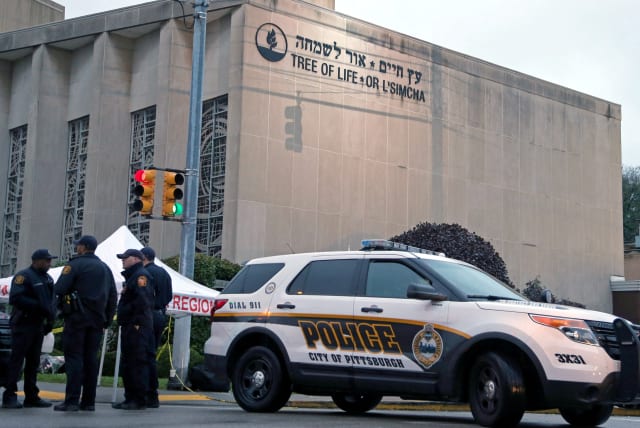Tree of Life congregation looks ahead as new synagogue building planned

The site of the Pittsburgh synagogue massacre will soon host the country's first antisemitism museum.
Demolition began this week at the Tree of Life synagogue in Pittsburgh, Pennsylvania, where 11 Jewish worshippers were killed on Oct. 27, 2018 in the most deadly antisemitic attack in United States history.
For synagogue President Alan Hausman, the demolition of the building brings up a gamut of emotions.
"It's the emotions from all the memories that were in the building, to the excitement of the new structure going up in the future, and everything that lies ahead of us," Hausman said.
Hausman said the building holds a mixture of memories, from lifecycle events congregants had there like weddings, Bar and Bat Mitzvahs, funerals and holiday celebrations, to the horrible memories of 2018.
"But we're also in a position to begin to make new memories, of a type that would have never been done before. You know, we're building a destination," Hausman said. "I tell people, we used to have just a synagogue. Now, we're going to have a destination where people can come and learn about what happened, learn about other faiths, learn about each other."
Hausman said he believes in sharing the story for people to learn about what happened at Tree of Life.

What happened on Oct. 27, 2018, didn't just hurt 11 families of the congregation, Hausman said. It hurt the entire city of Pittsburgh, the Commonwealth of Pennsylvania, and the country.
According to Hausman, it didn't take long for the congregation to realize the rebuilding process was beyond the scope of just the congregation.
An independent board was established with representatives from the community, congregation, victims' family members, the Holocaust center, as well as other entities.
"We realized we needed a way to tell the story of what happened here, and we created this board and over the course of a couple years, the vision began to slowly come together," Hausman said.
"This has never been done before," Hausman said. "You don't open a book and say wow, how do you do this?"
At first, the board discussed rehabbing the building and rebuilding it in the same format.
But after assessing the building, Hausman said the board realized it was practically impossible to make changes to the building without going into an area where someone had perished.
Hausman, who works in public safety as an emergency manager, acted as a liaison with law enforcement in the aftermath of the attack.
Hausman was vice president of the congregation at the time, but was four hours away from Pittsburgh when he got the 911 page, which he said he received before the first officer got on the scene.
Hausman said he helped law enforcement with a lot of evidence removal, and was able to show officers how to navigate through the building to find where some of the rounds of bullets went.
"I've been in the building 1,000 times since that day. I'd been in the building and saw some horrific things. I mean, public safety, I get it," Hausman said.
"But it's really hard to know they were your friends. Really, really hard," he added. "People that you spoke to, not just on Saturday at services, but throughout the week. Had real life experiences together."
Hausman said he also found it difficult when law enforcement began to remove religious items from the building, like the ark that held their torahs.
The new building, designed by famed architect Daniel Libeskind, will feature a sanctuary in the center, and also hold a museum, center for education, and memorial for the victims.
Michael Bernstein, chair of the Tree of Life Interim Governance Committee (IGC), which is overseeing the development of the new 501(c)3 organization, its programs and the building, shared Hausman's excitement for the educational opportunities of the new building.
"As a neighbor and resident of Pittsburgh, I'm excited to be able to have a building of such renown in our neighborhood," Bernstein said. "That in and of itself is exciting, but beyond that, it's what we're going to do inside the building as a new institution."
The building will host the country's first antisemitism museum, which Bernstein called an important and significant milestone for the Jewish community.
"Certainly, for those of us who went through the horror of Oct. 27, we feel we have the moral legitimacy to address some of these issues around how antisemitism continues to manifest itself," Bernstein said.
Hausman said the museum and educational center is a great opportunity to teach more than just tolerance, but acceptance.
"Tolerate means we'll deal with it, but we really don't like it. And when we tolerate people, that means I'm sitting in the room with you, I'll tolerate you, but the minute I leave the room, I don't like you. I don't want to deal with you and I don't want to see you again," Hausman said. "We need to learn to accept people."
Bernstein said he's excited to reach out to people who may not really understand the dangers and permutations of antisemitism.
The Path of Light
The hallmark of the building will be a glass atrium called the Path of Light, which Bernstein said will run the entire length of the building, starting at the victims' memorial and going through to the sanctuary.
"It will emanate light and welcoming, all the way to the entrance. Symbolically, metaphorically, as well as physically," Bernstein said. "It's an architectural gesture that I think is going to really wow people when they see it."
The 11 victims will be honored in a memorial park outside the building, each represented by a book of life containing details around each of their lives, how they lived, and what they represented, Bernstein said.
Groundbreaking on the new building is expected to begin midyear and take almost two years to complete.
